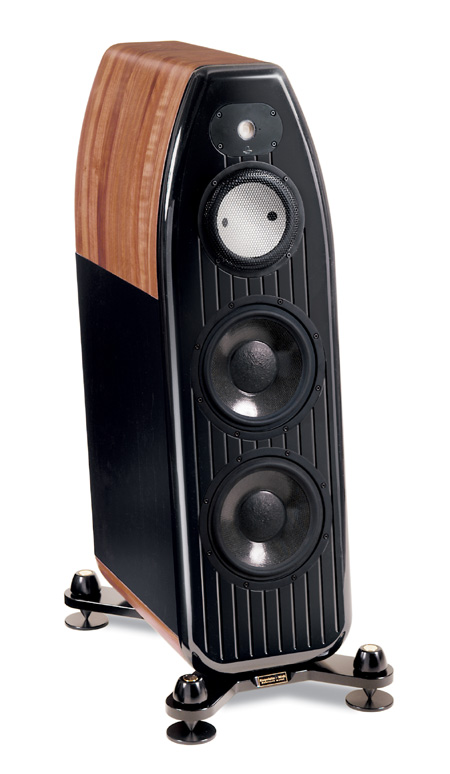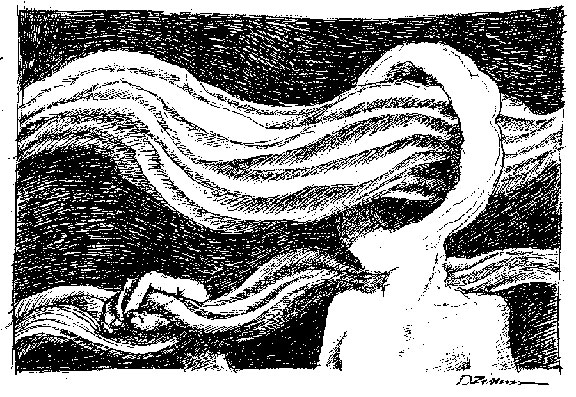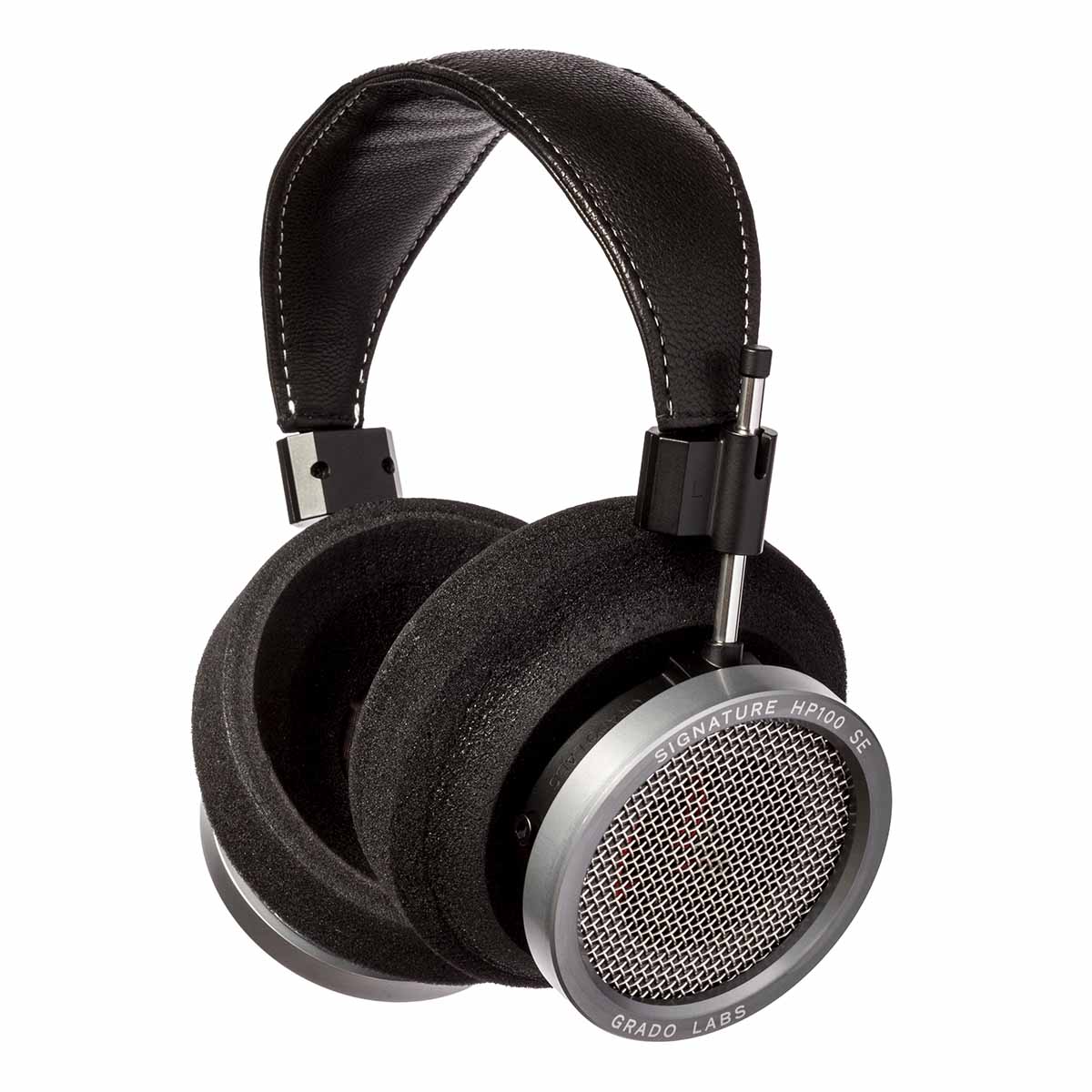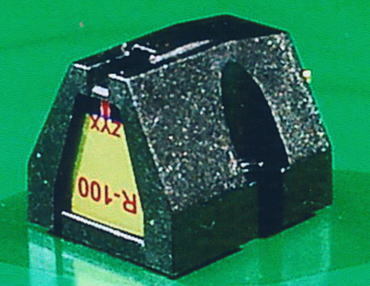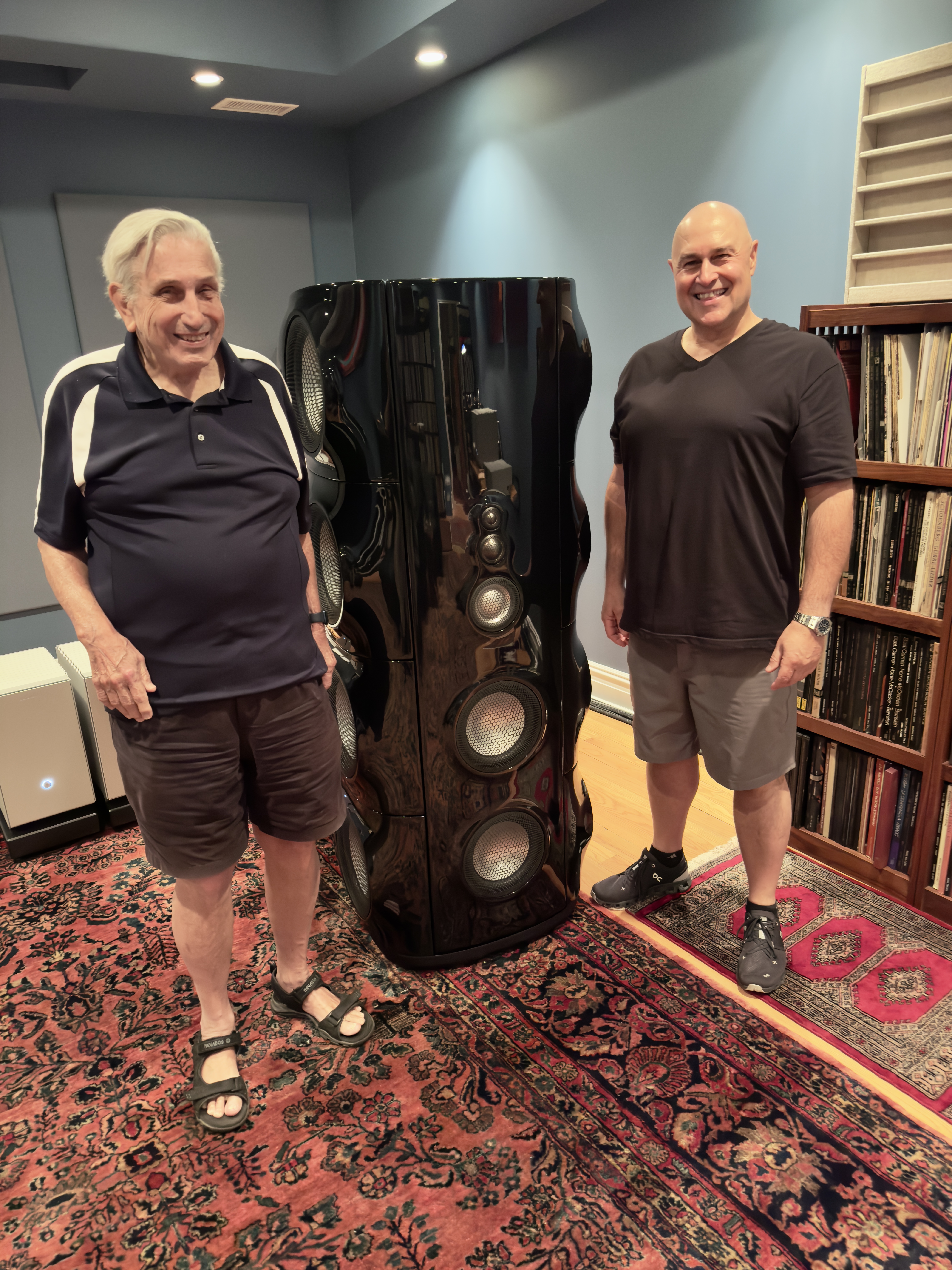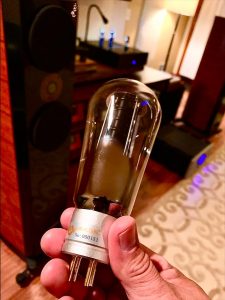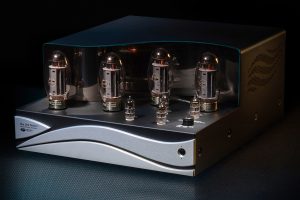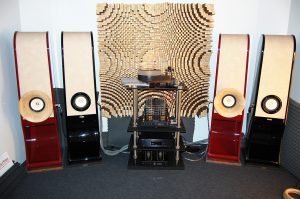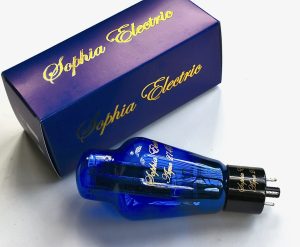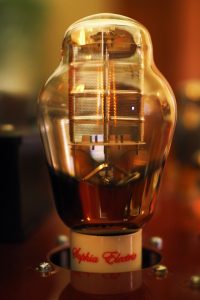This article, by Harvey Rosenberg, originally ran when Positive Feedback was in print - Vol. 7, No. 6, 1998.
During my short tenure as PF's Techno-Shaman of Coolosity I have suggested that you, while artifying your harmonic/space/time continuum in your expanded aural matrix, consider single-ended triode amplifiers with tube regulated power supplies, Nobu Shishido's Inverted Interstage Transformer coupled SET amplifiers, David Berning's ZOTL, and now the Sun Audio's transformer phase splitter 300B transformer coupled push/pull amplifiers... all directly heated triode amplifiers, all unique high expressions of the outer edge of the thermionic arts. This is truly a golden age of thermionic creativity, and I am honored to take you to these exotic places of beauty.
A LITTLE BROWN MAN WITH BIG WHITE KNOBBY KNEES DELIVERS POETRY
The little brown man with big white knobby knees at my door was not an alien from Music HyperSpace, but the UPS delivery man, who was delivering to me thermionic works of art from a still alien culture to readers of PF.
In about fifteen minutes the amplifiers from over the harmonic horizon were unpacked, connected it to my Manley 300B line stage and I was listening to Samuel Barber's Adagio, and I almost instantly began to slide into an oblivion of beauty; my entire body started to quake and tears filled my eyes... I was so overcome with emotion that I ran to my CD player and asked Puff Daddy's score for Godzilla to rescue me from this totally unexpected emotional piercing. Then to bring sheen back to my funk I danced to Erykha Baduh's Tyrone. To bring coherence to this emotional aural expansion I drove to the beach, near my home, mid taking a full breath of the sea's musical aroma I wrote this poem, dedicated to you, the gifted listeners of PF:
Black Greasy Fingernails
I love men in their old leather jackets,
Which speak of long roads traveled by moonlight.
I love men with black greasy fingernails,
Muscle tugging at bolts building beautiful cars.
I love men who hunt beasts,
Pray and eat their hot dead hearts in thanks.
I love men who look into the sky,
And build monuments to fill their empty space.
I love men who pick up soldering irons and dance in Music HyperSpace
I love men who bend their fingers around instruments and play their scars away.
We are One Soul on Fire.
Do you understand how moved I am by the Sun Audio SV-300B MKII mono transformer phase splitter push/pull amplifiers from Japan? Can you vibe how blessed I am, once again, to experience audio art that compels poetry, dance and celebration? Do you remember my Rimbaud (not Rambo) like exaltation over Nobu Shishido's amplifiers? Does anyone have the mettle to stand up to me on this assertion: great audio art is a can opener of the soul, in exactly the same way as Van Gogh's paintings?
Like the David Berning 300B ZOTL amplifier I am now introducing you to another "classic" and "revolutionary" amplifier that demands our attention. I consider this the beginning of the next wave in push/pull transformer amplifiers, and any audio dealer that doesn't sell it is either stupid, deaf or just doesn't get it. Members of the legion of artistically sensitive men who love their pentode push/pull amplifiers gather your courage and audition this amplifier. Don't forget there are three great peaks in Triodeville... Mt. Single-Ended, Mt. Push/Pull and Mt. OTL, and I love looking out from each peak because each has it own unique beauty. This is a very popular product in Japan, and for good reason.
THE THERMIONIC TIDES
We are all swimming in the tides of the audio arts; they are deep, powerful and they flow from continent to continent, rich with new life, feeding on the leviathans that are no longer. We swim with these tides, and we struggle against them, but we are only bubbling on the surface of these unfathomable depths. Standing on the beach, the smallest waves lapping on our feet are connected to the storm in the wide Sargasso Sea, and yes, that tugging is pulling us into the darkness, tugging us back to the eternal music cradle.
Pay no attention to the topless nubile nymphet sprawled on the blanket. Listen instead, listen to the cawing of the gulls, the winds brooming the sand, listen to the harmonics from over the horizon. The next thermionic wave has left Japan's shore and is squiding to our shore. Push and pull, tug and twist all you want... its time has come... the Sun is rising in America.
THE TRUTH IS POWERFUL
The American single-ended revolution has come to a temporary halt in the same way there is quiet after the storm. Before it can take its next leap forward (1) The American Priests of the Temple of Monkey Coffins must recover from the collapse of The Solid State, which reigned temporarily for the last two decades, (2) Much more consideration must be given to, meaning higher quality, power supplies and output transformers.
On the other hand, single-ended amplifiers have Hoovered up all of the attention of the vanguard of the thermionic revolution, and now it is time to re-stimulate attention on this next Wave… reinventing push/pull circuits… which have exhausted themselves, like the Cold War superpowers, in the horsepower race of brutish pentode complexity and astronomic cost. Let us not forget America's dominant aesthetics are Wretched Excess and The World Federation of Wrestling.
In the same way I have suggested that there are artistic boundaries to single-ended circuit, I am also suggesting there are artistic limits to push/pull circuits ... of course this is true in all art forms. But there is no limit to the horsepower race if you are ready to deal with the heat, the electricity bills and the inherent instability and unreliability of these multi-tube behemoths that glow in the dark. Let me say this another way: tubes are to transistors, as triodes are to pentodes. Pop a Prozac and just give this piece a chance.
The tides are shifting and we are returning to a time, the 1970s, when a 60 watt push/pull amplifier was consider humongous. I refer you to my first book, Understanding Tube Electronics, A Study in Natural Harnionics Audio, in which I stated that, after listening to almost every tube amplifier that money could buy, the most authentic were the smaller ones (see Triode Guild web site for pictures of my 1979 ultra-tweaked push/pull amps). I believe that this Sun amplifier, like the classics of that period—the Marantz 9 and 8b and the MacIntosh series—defines goodness and virtue in their genre.
All things being equal, a lower powered, simple push/pull amplifier using directly heated triodes, made with high quality parts, with a well regulated power supply, and with the right way of achieving symmetry will be more musically satisfying than a large complicated pentode amplifier.... if used with the right speakers. Have you got a clue of how difficult it is to get four, six, eight, ten or sixteen tubes to be perfectly balanced? It is impossible, and I am not talking about static bias and balance measurements, which mean very little.
In Japan, where audiomaniacs study the literature (and from the beginning of audio time), the literature is quite clear that the most daunting task is designing a symmetrical phase splitter. There are hundreds of ways of splitting the signal, each with its advantages and disadvantages (order back issues of Glass Audio, Vol 6, #4, Vol 7, #3), but none of these are equal to the precision and finesse of using a very high quality "transformer phase splitter." Fritz, the 500 year old audiomaniac vampire, insisted that I put some schematics of amplifiers from the 1930s on The Triode Guild to demonstrate, once again, The Ancient Wise Ones' wisdom. Just check a schematic of any Audio Research amplifier and you will see the enormous complexity Bill Johnson has put forth to keep everything symmetrical, and then compare that to the stark simplicity of this amplifier's front end!
Why don't more audio designers use transformer phase splitters? For good reason: they haven't been available in America since the 1970s because the art died here (but that is changing), and most importantly ... high cost. A high quality/wide bandwidth transformer phase splitter can cost as much ($200-300) or more than an output transformer, while a conventional tube phase splitter cost what a few tubes, resistors and capacitors cost. Of course in Japan the master transformer winders, such as Tango and Tamura, have kept this art alive and taken it to new heights, because the Japanese are ready to embrace the "ancient" wisdom... because it creates the greatest beauty... it works best. There is no reason why our top tier tube manufacturers can't use and boast that they use a Japanese manufactured transformer phase splitter. This is a no-brainer for the ego secure. Check both Glass Audio and Sound Practices for suppliers of interstage transformers.
THE MANLEY RETRO 300B PUSH/PULL RELIGHTS MY FIRE
You know I love the Manley Retro 300B amp because it is the perfect polygamous amplifier... it is single-ended and or push/pull, and I can adjust the feedback with a knob. It stoked my push/pull fires again, and for many good reasons:
(1) It uses 300Bs, which have a superior tone compared to pentodes. We have an expanding cornucopia of 300B brands to use, and I can twiddle with different brands of input tubes, and rectifiers. The combination of 300Bs and octal driver tubes is a very different taste and aroma than pentodes driven by miniature triodes. It is obvious to me that 300Bs in push/pull have the capacity for very low distortion, superior transient response, and superior tone.
(2) It has adjustable feedback, which means I can "tune" the amplifier to the speakers and individual music, and this is an extremely important feature, especially because I can choose "no feedback". Personally, most of the time, I gladly pay the price for no feedback.
(3) It is enormously powerful at 40 watts ... compared to 5-7 watts of 300B single-ended power, which means I can listen to a very wide range of loudspeakers that are 85dB and up efficient. I will be badgering you over and over again that TWO (maybe four) tubes are the optimum configuration for push/pull circuits if you are seeking mystery. That means two, or maybe four 300Bs. While there is legitimacy in designing with 2A3, 845 or 811 family of tubes (there are virtues in each), all I can say is that the 300B is still the most perfectly balanced tube for me... but remember I am a 300B maniac (Check the Triode Guild web site for "The Return of King Tone").
(4) Push/Pull amplifiers are more dynamically coherent than single-ended amplifiers, and if you love rock and roll and orchestral music this matters. This will also matter to those who have not taken a vow of celibacy, like yours truly, and are interested in making love while listening to music. If you want to experience the rich primal juice of music, then push/pull is the way to go, and you are hearing that from one of the primary promoters of single-ended circuits.
(5) And let me emphasize again the unabashed real-worldosity of push/pull circuits... (again) which means that single-ended circuits must be connected to high impedance/high efficiency speakers of uniform impedance, and there are as many of those in America as there are Presidents who didn't have sex in the White House. In other words (pay attention to Scott Frankland's comments—see Positive Feedback, Vol. 7, No. 4) with "normal" high end speakers you should use push/pull amplifiers.
In summary, the brilliant Manley Retro 300B amps in Push/Pull mode reintroduced me to the unrealized artistic possibilities of 300B push/pull amplifiers, and stimulated me to reach out to Sun Audio in Japan. I have been waiting for these amplifiers for two years, and it has been worth the wait.
THE CULTURE OF TONE
"In a digital world nothing is more important than tone."
I can spend two or three thousand pages explaining the Japanese audiomaniac's advanced aptitude at creating audio devices of extraordinary tone, or, you can go to your local museum and spend a fine day grocking Japanese art. Their audio art emerges from their unique artistic tradition. Check out the porcelains, the lacquers, the silk paintings or silk costumes, or the Samurai armor. Pay careful attention to the finish, the texture and sheen in their art. Here the phrase "glowing with inner light" applies grandly. The Metropolitan Museum of Art in New York City has a fine Japanese art collection worthy of your attention. On the other hand if you are living in an igloo on the North Pole, go to your local library and get some books on Japanese art. Spend some time doing this before you read on so you will grasp what I mean about "tonal sheen". Music pedagogues call this "burnished tone". Those who play Stradivarius violins, or a Steinway Concert Grand needn't bother because you eat tonal sheen for breakfast. This is the difference between Pablo Casal's burnished tone and Yo Yo Ma's tone.
Those of you who are connoisseurs of Japanese cooking know the taste of this tonal subtly. And this also explains why this is the land of the Alnico magnet speaker. Who are the consumers who used their dollars to force the renaissance of directly heated triodes?
In my articles about the now eternal Nobu Shishido, I asserted that his audio art emerged from the Japanese culture and their artistic priorities, and they are very different than ours. You, the elite gifted listeners in America, are evolving and learning about subtle tonality, in the same way the Japanese are growing and learning about the transcendent beauty of Harley-Davidson motorcycles which are also fine musical instruments. This international artistic convergence is the new revolution! Big is to America, as subtlety is to Japan, and remember this paradox: Japan taught us about the beauty of our Western Electric tubes.
And if all of the above artistic exploration doesn't fit into your busy schedule just read Chapter 7 of Music, Physics and Engineering by Harry Olsen, in which the Godfather of the audio arts discusses the primacy of tone in audio systems. So it is not by accident that Mr. Uchida, the owner of Sun Audio, repeats the word "tone" over and over again in his catalog, and it is not by accident that this same word is used over and over again in the Tamura catalog, and it is not by accident that Mr. Uchida once worked for Tamura.
MUCH COOLER THAN A ROLEX
In my conversation with Nobu about the design goals of the WAVAC amplifiers he was clear in explaining his goal of integration between their physical beauty and their aural beauty, and this artistic wholeness is the aesthetic platform of Japanese art. So let me be plain about these amplifiers: they are works of art. They have a unique "classic" beauty both physically and tonally. To my trained eye they are an "ideal" transformer-coupled push/pull tube amplifier. There is a chunky symmetrical perfection to them; a cross between a fine piece of military electronics and a fine lacquered box. They are a deep charcoal gray, and I love their deep matte enamel finish. But it is the sculptured beauty of the Tamura transformers that define their thermionic totemic beauty, rightfully so. When these amplifiers speak, they proudly boast... TAMURA TRANSFORMERS. These mono amps are not large, and they remind me of the kind of chunky design self- confidence that we see in the MacIntosh 275, which means you can, and should, show them off, and never have to worry about cluttering your room or getting a divorce. Consider putting these amplifiers on a pedestal, or speaker stands... that is how superb they are as tube art.
Why is the Guildmeister of Triode Guild, the man who is America's most aggressive promoter of OTL amplifiers, so impressed by these transformer phase splitter/transformer output amplifiers ... that's a lot of iron? The answer is the quality, quality, quality of the iron makes the difference, and it is (again) safe to say that 99.999999% of American audiomaniacs have not experienced the level of transformer quality in the Sun and the WAVAC amplifiers, but when you do, you will understand what you have been missing. Those of you who read Glass Audio are aware of Nobu Shishido's emphasis on the importance of transformer quality. It is also possible to order these amplifiers with the highest quality Tamura output transformers for an additional charge.
My only criticism here is that the knob on the input pot should a 1940's design, and the speaker binding posts should be of higher quality, but this is an easy retro-fit, especially if you buy these amplifiers in kit form... but hold on, I will deal with this later on.
My suggestion for Mr. Rich Guy is to buy a dozen pairs of these amplifiers and put them in your boat, your office, your garage, your bedroom, living room and den... they have they kind of masculine beauty we associate with Rolex watches ... if you get my point about testicular beaudacity?
IS A TUBE A STRADIVARIUS VIOLIN?
What a silly question. Of course a tube is a fine hand-made musical instrument, which is why we love figuring out which combination creates the tone we prefer. This statement explains the artistic transcendence of tubes in audio circuits which always must be tuned for optimum pleasure. The musical dread of transistor and digital audio is that they have so little tuneability.
In the same way Americans know how to make great tasting hamburgers, there is an tube gourmet orthodoxy in Japan which has now migrated to America... 6SN7 /voltage amp driver, 300B output tube, and 5U4G tube rectifier... stray too far from this gourmet combo and the aroma and taste of music, the tonal sheen, will falter. And while this may seem an artifact of culture, the 300B is a much more linear, lower distortion tube (and it is from 1936) than your typical modern 6550, meaning it needs little or no feedback, and the 6SN7 is superior to a miniature triode of the 12AX7 kind.
But let me go further... if you want to fully fathom the tonal glory of these extremely serious amplifiers, you must use the best possible tubes which means: (1) hunting for NOS pre-1960 6SN7, especially the Western Electric brand made by Sylvania. Buy lots of different brands and gladly pay for the best, because nothing is more important and more fun, than fine-tuning the tone of your amp with the first tube. (2) picking the 300B brand that pushes your ecstatic button, and today your choices are very great indeed (note: there are no bias and balance controls here, so you must use matched pairs of tubes), and (3) buy a NOS RCA or equivalent tube rectifier. If you can't afford this combo, buy the best tubes you can afford and then save up and trade up.
I don't understand why so many American's use solid state rectification in small tube amplifiers when it is a guarantee of tonal deterioration. I remind you of my experience with two versions of the Manley Retro amps (solid state and tube rectification), and hands down chose the tube rectifier model. The price you pay for tonal sheen... some tightness in the bass. The tonal quality of your power supply matters!
On the Triode Guild web site is a schematic of this amp, and I will make some brief comments about it here. You immediately note how simple this circuit is: no coupling caps, a 6SN7 input tube connected to a transformer phase splitter which drivers the output stage. The power supply has a choke, which is rare in America, and there is no feedback. That is about as simple as you can get in a push/pull amplifier. "Less is More" also applies to push/pull circuits.
One very interesting feature of the Sun amp is that the 300B's B+ voltage is only 320V, which is substantially less than the "normal" 400-450 Volts. This operating point is probably chosen because it creates the tone that Mr. Uchida prefers. This is only a 20 watt amplifier (the Manley is 40 watts) which means you will get maximum tube life. It is possible to let twice the horsepower out of the same air of tubes, but you pay the price in longevity.
THE IRON HEART OF SUN
Now we get the heart of these amps...(the soul are the tubes), and it is the Tamura transformers. The Japanese audiomaniac is very transformer savvy, and Japanese audio publications spend a great deal of time analyzing and reviewing output transformers because of the artistic intensity and curiosity of home tube amplifier builder. The Japanese audiomaniac knows it makes sense to save and buy the best transformers possible because, once you own them, you can use them as the basis of building any number of custom circuits. Ten years from now you can build a new single-ended or push/pull circuit with the same quality "classic" iron. The same high standards are also applied to the tonal quality of power transformers and chokes, which is a consideration that Americans don't yet understand.
My triode bro' Fabio Camaroni, who may be the current incarnation of Michaelangelo, the editor of the Italian audio magazine, Cositruire, lives and breathes Tamura transformers, which doesn't mean he doesn't also love OTLs.
I just received my first copy of Charles Kittleson's Vacuum Tube Valley magazine, and did a swan dive into my birdbath I was so excited. It has taken twenty years, but America's West Coat thermionic techno-shamans are setting the pace in doing what our Japanese bros' do for fun ... comparing the sound of different brands of output transformers. Check the Triode Guild web site for a reprint of VTV's 300B/single ended transformer evaluation. This is an extremely important activity, because the force that drives up the quality of American tube amplifiers is your sophistication... you only get what you deserve!
Arthur Loesch, one of America's most revered up-state New York thermionic techno-sharnans, is absolutely right in his assertion that the missing element here, the one that releases the nascent magic of directly heated triode is power, output, and phase splitter transformers of the Tamura/Tango quality. While this will cause many of you anxiety (it is a small price to pay for expanded thermionic consciousness) I insist, as your beloved Guildmeister, that you (I will not stop rny insistence) pick up the phone and call the Sun importer and get a copy of the Tamura transformer catalog, or go to the Sun Audio Web site at www.2.big.or.jp/~sunaudio.
These high quality transformers are not yet available in American "store bought" tube amplifiers, and I can't emphasize too strongly what a difference this makes in tonal sheen, transient response and clarity. When you peruse the Tamura transformer catalog you are looking at a technically sophisticated company that makes a wide range of industrial transformers. With their audio transformers this clearly is a case of science serving art, because winding audio transformers, at this level of quality is an art, and their customers demand it, and so should you.
Steve Berger of AprilSound imports a number of ultra-high quality Japanese transformer brands, including Tango, and you should get his catalog ((212) 242-9515), and check his web site: http://home.earthlink.net/~aprilsound/ to get a better understanding of the choices our Japanese bros' have and we don't. Steve's site has a high slew of really interesting, edge of the art, directly heated triode amps and schematics that you should also check out.
How many times have I ranted that "normal" aluminum electrolytic power supply capacitors are tonal arsenic, which is why I use oil capacitors, which require chassis yardage to use? But there is a tonally cool power supply capacitor; it is a Elna brand Cerafine capacitor (check Michael Percey's catalog for these type of capacitors), which has a unique construction.... The Sun sheens because of the quality of its components, which is rare in America... you can't fool Mr. Japanese Audiomaniac.
I have also included on The Triode Guild web site an illustration of the "inside" construction of these amplifiers because these are available as a kit, and are only slightly more complicated than assembling single-ended amplifiers, which is as easy as it gets. This illustration is important for another reason: It illustrates that there are no circuit boards here. This is all hard-wired, and for a good reason: hardwiring gives maximum tonal sheen. You notice the classic beauty of 1940s type military wiring, and it should not surprise you how much attention is put into the "beauty" of the wiring layout.
If I were building the kit I would use all solid silver wire, or solid copper wire with cotton insulation, and better quality input and output connects. Edison Price pure beryllium copper speaker binding posts available from Eminent Technology (904-575-5655) is a highly recommended addition. Anyone who has built any of the Cary Audio, AudioNote, or Welborne kits are more than qualified to take on this challenge... and this is the real McCoy. This is my suggestion when assembling: sip the finest Saki, wear a silk kimono, and listen to Kodo music... make the connection to our Japanese audiomaniac brothers.
CAN YOU BEAT THIS, MY FELLOW 300B MANIAC?
I got up early in the morning and ate a bowl of breakfast cereal in the shape of 300Bs with milk from cows that listened to the music of Tammy Wynette playing on a 300B/Alnico barn sound system while they were being milked. Then I took a shower with a bar of directly heated soap in the shape of a 300B, put on my 300B T-shirt, turned on my Manley preamp that has a 300B output stage and turned on the Sun amps.... can anyone top that 300B mania? You know my email address. ([email protected] for those who don't.)
One of my high traffic email questions is about which brand of 300B I recommend. Because of these amps' refinement they are perfect for "The Directly Heated Karma Sutra Part 1: World's First X-Rated 300B Evaluation", which will shortly appear on the Triode Guild web site — be prepared for some big surprises. But now let me point out that every tube maker is getting higher on their 300B learning/quality curve, which means that with the increasing demand for 300Bs, quality and consistency is better across the board, and there are new 300B "variants" that are woodifying.
HOW DOES THE SUN SOUND?
Those who need more than 7-10 watts, yearn for that directly heated single-ended magic, and want the dynamic coherence and full frequency response you can only get from a push/pull amplifiers with real world speakers, have now had their dreams answered. Those who want that single-ended refinement and are thinking about getting a powerful single-ended amplifier (15-20 watts) such as an 845, 211 or 811 stop, and check these amplifiers out. Let me remind you that these amplifier still need a relatively high efficiency speaker ... 85dB+/NOT 4 ohm, but there oodles of this sort available.
Power freaks stop reading now and go to the notable Brad Meyer's web site "How Much Power Do You Need" at www.smr-home-theatre.org/Power/index.html, and check out the loudness/efficiency/power table and you will discover that with an 87dB+ speaker you can cause ear damage with 20 watts. With 99dB efficiency is only takes 1.3 watts to cause the same damage.
The dynamic quality of these amps is totally dependent on your speakers... with the Sunlight Engineering 308s they are equal to Pratt and Whitney jet engines.
May I be bold and vain? I only write about significant audio art. These amplifiers are significant for an extremely important reason ... the debate about single-ended versus push1pull has now moved to a much higher ground. What we have found artistically crude about push/pull amplifiers is not an inherent quality of push/pull circuits, but the way we execute this principal in America. I am asserting there — and it is proved by the Sun amplifiers—that the disdain we feel for the tonal discombobularity, lack of refinement, midrange choppiness, and aural flatulence of push/pull amplifiers is not a design imperative. The Tamura tramformerphasesplitter is a way big deal. The Sun amplifiers has proved to me that, when done right, push/pull is much more than we imagined. This the first time I have absolutely no trouble not listening to my single-ended 300Bs ... let me say that differently.... my SETs haven't been used in weeks!
Another highly respected thermionic techno-shaman, and fellow editor of PF, Lynn Olson, also believes that the next wave is transformer phase splitter/directly heated triodes, and for the last year has been perfecting his own extremely refined version of this concept using Lundahl transformers.
Go to www.teleport.com/~lynn/ABC.html to check out his truly innovative design and schematic. Note the tube regulation!
Do you need more validation?: When discussing this article with the loftiest of lofty, Eric Barbour of Svetlana, he too agreed that a high quality transformer phase splitter was optimal for push/pull circuits ... and directly heated triodes pushed the boundary of push/pull possibilities.
Does the Sun amp have the sublime subtle midrange coherence and juice of my best single-ended 300B amps? No, but SET amps are, in effect, midrange amplifiers and do not have the ability to play with most speakers... how many of you own 100 dB + Tannoy horns or the Sunlight Engineering 308s? The bigggg difference here is that the Suns can create a coherent musical wavefront, from top to bottom, that no single-ended circuit can. There are very few "store bought" tube amplifiers (because they are pentode) that have this tonal rightness and I have explained why.
There are two groups of music lovers I wish to address: jazz and chamber music maniacs, two genres where the priority of tone is obvious. You must experience this type of music with a 300B amplifier.
I am aware of how desperate brainy analytical audio professors are (those still stumbling around in the dark dank basement of the disintegrated "accuracy metaphor") for me to describe these amplifier's individual attributes, and compare them to my other amplifiers. Well, I guess you missed the whole point of this article. I don't analyze... I integrate, and I don't compare Van Gogh to Picasso. A wholey man's job is integration. Go back to the top and re-read it... these amplifiers made me write poetry, cry and dance, and that is about as wholey as I can get when it comes to an audio gizmo. Will the Sun amps make you cry and dance and write poetry? Only you can discover that. Do you have the same type of brain damage as I do?
TOP SECRET: Because you know me well, you know I will not be able to resist connecting some of my industrial tube regulated power supplies to these amplifiers to discover their effect...but you will have to go to the Triode Guild web site to get the results of my experiments.
A pair of these mono amps cost $6250 without tubes. The kits cost $5,000, which should give you an indication of just how serious the DIY market is in Japan. I do not know of anything in America that equals this extreme quality in the category of 300B push/pull amplifiers. Are there any? Like the WAVAC amplifiers these amplifiers can never become obsolete. These are classics.
You will find the Sun Audio catalog a trip to an exotic land. Those who are in love with single-ended amplifiers will be thrilled by Sun's single-ended amps, and there are a many other push/pull amplifiers and some exotic phono preamps and line stages... all express the same passion for tone.
Some advice for audio dealers: these are the real McCoy and a great way to get curious gifted listeners into your audio space. Strike up the band and let's start dancing to our favorite tune... Less is More.
Wake up American tube amplifier designers, the next wave is building... surf it, don't be drowned by it... start designing your high quality 300B push/pull/transformer phase splitter amplifiers... this is a very juicy wave, and worth surfing. And my fellow gifted listeners—can we be certain that the American Priests of the Temple of Monkey Coffins have the intellectual heft to get their high efficiency act together ?
Now that was really good for me. Was it good for you?
Celebrating your wholey dudeness, and reminding you that you are music, I remain,
Dr. Gizmo
SUN AUDIO is imported HA Imports (Yong Kim)
503-644-7282
Fax 503-644-6713
Email: [email protected]
ASSOCIATED EQUIPMENT
The entire cosmos of multi-dimensional musical consciousness
Cindy Crawford's belly button
Ripped jeans
Cohiba cigar
Worn out blue sneakers
Silk Kimono
French bees wax candles
Coconut oil
Swedish masseuse
Mickey Mantle baseball card
Pez Dispenser
Assorted Beeny Babies
Dick Tracy Secret Decoding Ring
Pee Wee Herman doll





